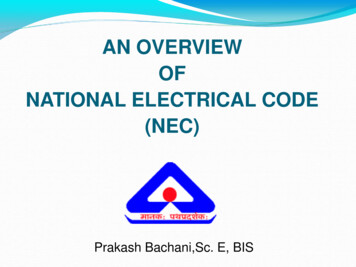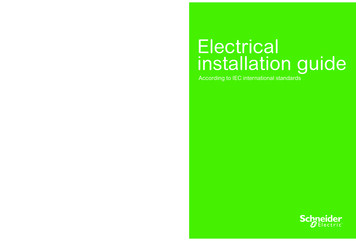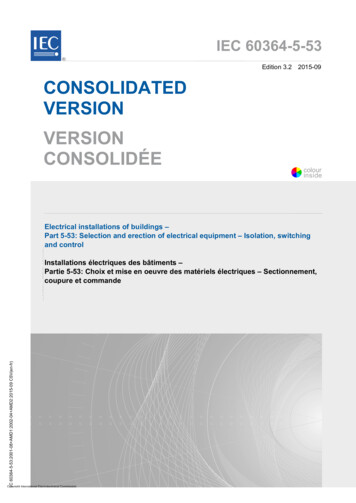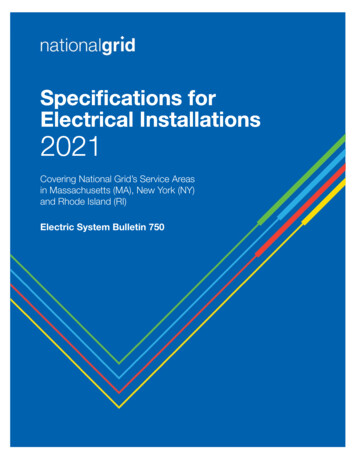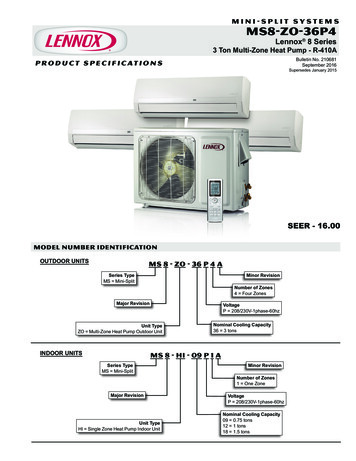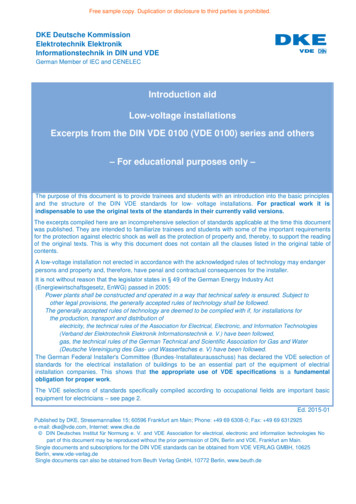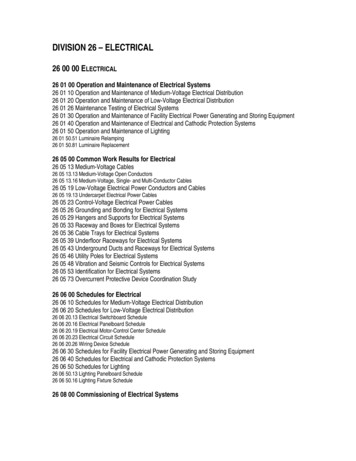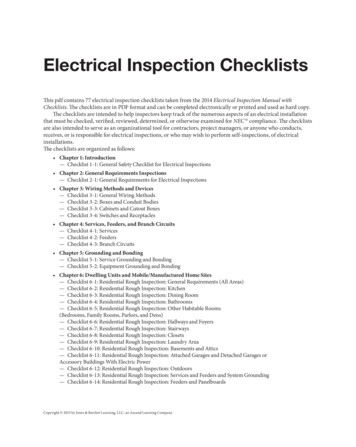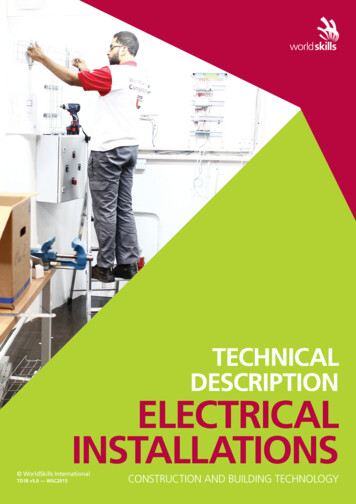
Transcription
TECHNICALDESCRIPTIONELECTRICALINSTALLATIONS WorldSkills InternationalTD18 v5.0 — WSC2015CONSTRUCTION AND BUILDING TECHNOLOGY
WorldSkills International, by a resolution of the Technical Committee and in accordance with the Constitution,the Standing Orders and the Competition Rules, has adopted the following minimum requirements for this skillfor the WorldSkills Competition.The Technical Description consists of the following:12345678910INTRODUCTION . 2THE WORLDSKILLS STANDARDS SPECIFICATION (WSSS) . 3THE ASSESSMENT STRATEGY AND SPECIFICATION . 8THE MARKING SCHEME . 9THE TEST PROJECT . 14SKILL MANAGEMENT AND COMMUNICATION . 21SKILL-SPECIFIC SAFETY REQUIREMENTS . 22MATERIALS AND EQUIPMENT . 22VISITOR AND MEDIA ENGAGEMENT . 25SUSTAINABILITY. 26Effective 12.08.14Stefan PraschlChair Technical CommitteeMichael FungVice Chair Technical Committee WorldSkills International (WSI) reserves all rights in documents developed for or on behalf of WSI, including translation and electronicdistribution. This material may be reproduced for non-commercial vocational and educational purposes provided that the WorldSkills logoand copyright notice are left in place.WSC2015 TD18 ENDate: 12.08.14 – v5.0 WorldSkills International. All rights reservedELECTRCIAL INSTALLATIONS1 of 26
1 INTRODUCTION1.1 NAME AND DESCRIPTION OF THE SKILL COMPETITION1.1.1 The name of the skill competition isElectrical Installations1.1.2 Description of the associated work role(s) or occupation(s).An electrician works on commercial, residential, agricultural and industrial projects. There is a directrelationship between the nature and quality of the product required and the payment made by thecustomer. Therefore the electrician has a continuing responsibility to work professionally in order tomeet the requirements of the customer and thus maintain and grow the business. Electrical installationis closely associated with other parts of the construction industry, and with the many products thatsupport it, normally for commercial purposes.The electrician works internally, including the homes of customers and on small and major projects. Heor she will plan and design, select and install, commission, test, report, maintain, fault find and repairsystems to a high standard. Work organization and self-management, communication andinterpersonal skills, problem solving, flexibility and a deep body of knowledge are the universalattributes of the outstanding electrician.Whether the electrician is working alone or in a team the individual takes on a high level of personalresponsibility and autonomy. From working to provide a safe and reliable electrical installation andmaintenance service, in accordance with relevant standards, through to diagnosing malfunctions,programming and commissioning home and building automation systems, concentration, precision,accuracy and attention to detail every step in the process matters and mistakes are largely irreversible,costly and potentially life threatening.With the international mobility of people the electrician faces rapidly expanding opportunities andchallenges. For the talented electrician there are many commercial and international opportunities;however these carry with them the need to understand and work with diverse cultures and trends. Thediversity of skills associated with electrical installations is therefore likely to expand.1.2 THE RELEVANCE AND SIGNIFICANCE OF THIS DOCUMENTThis document contains information about the standards required to compete in this skill competition,and the assessment principles, methods and procedures that govern the competition.Every Expert and Competitor must know and understand this Technical Description.In the event of any conflict within the different languages of the Technical Descriptions, the Englishversion takes precedence.1.3 ASSOCIATED DOCUMENTSSince this Technical Description contains only skill-specific information it must be used in associationwith the following: WSI – Competition RulesWSI – WorldSkills Standards Specification frameworkWSI – WorldSkills Assessment Strategy (when available)WSI – Online resources as indicated in this documentHost Country – Health and Safety regulationsWSC2015 TD18 ENDate: 12.08.14 – v5.0 WorldSkills International. All rights reservedELECTRCIAL INSTALLATIONS2 of 26
2 THE WORLDSKILLS STANDARDSSPECIFICATION (WSSS)2.1 GENERAL NOTES ON THE WSSSThe WSSS specifies the knowledge, understanding and specific skills that underpin international bestpractice in technical and vocational performance. It should reflect a shared global understanding ofwhat the associated work role(s) or occupation(s) represent for industry and business(www.worldskills.org/WSSS).The skill competition is intended to reflect international best practice as described by the WSSS, and tothe extent that it is able to. The Standards Specification is therefore a guide to the required trainingand preparation for the skill competition.In the skill competition the assessment of knowledge and understanding will take place through theassessment of performance. There will not be separate tests of knowledge and understanding.The Standards Specification is divided into distinct sections with headings and reference numbersadded.Each section is assigned a percentage of the total marks to indicate its relative importance within theStandards Specification. The sum of all the percentage marks is 100.The Marking Scheme and Test Project will assess only those skills that are set out in the StandardsSpecification. They will reflect the Standards Specification as comprehensively as possible within theconstraints of the skill competition.The Marking Scheme and Test Project will follow the allocation of marks within the StandardsSpecification to the extent practically possible. A variation of five percent is allowed, provided that thisdoes not distort the weightings assigned by the Standards Specification.WSC2015 TD18 ENDate: 12.08.14 – v5.0 WorldSkills International. All rights reservedELECTRCIAL INSTALLATIONS3 of 26
2.2 WORLDSKILLS STANDARDS SPECIFICATIONSECTIONRELATIVEIMPORTANCE(%)15Work organization and managementThe individual needs to know and understand: Health and safety legislation, obligations and documentation The principles of working safely with electricity The situations when personal protective equipment must be used The purposes, uses, care, maintenance and storage of all tools andequipment together with their safety implications The purposes, uses, care and storage of materials The importance of keeping a tidy work area Sustainability measures applying to the use of ‘green’ materials andrecycling The ways in which working practices can minimize wastage and help tomanage costs whilst maintaining quality The principles of work flow and measurement The significance of planning, accuracy, checking and attention to detailin all working practices Impact of new technologyThe individual shall be able to: Follow health and safety standards, rules and regulations Diligently follow electrical safety procedures Identify and use the appropriate personal protective equipment includingsafety footwear, ear and eye protection Select, use, clean, maintain and store all tools and equipment safely Select, use and store all materials safely Identify and take care of expensive fixtures/fittings Plan the work area to maximize efficiency and maintain the discipline ofregular tidying Measure accurately Manage time effectively Work efficiently and check progress and outcomes regularly Establish and consistently maintain high quality standards and workingprocesses2Communication and Interpersonal Skills10The individual needs to know and understand: The significance of establishing and maintaining customer confidenceand trust The importance of maintaining and keeping knowledge base up-to-date The roles and requirements of related trades The value of building and maintaining productive working relationships Techniques of effective teamwork The importance of swiftly resolving miss-understandings and conflictingdemandsWSC2015 TD18 ENDate: 12.08.14 – v5.0 WorldSkills International. All rights reservedELECTRCIAL INSTALLATIONS4 of 26
The individual shall be able to: Interpret customer requirements and manage customer expectationspositively Provide advice and guidance on products/solutions e.g. technologicaladvancements Visualize and translate customer wishes making recommendations whichmeet/improve their design and budgetary requirements Question customers closely/deeply to fully understand requirements Provide clear instructions Introduce related trades to support customer requirements Produce written reports for customers and the organization Produce a cost and time estimate for customers Recognize and adapt to the changing needs of related trades Work effectively as a member of a team3Problem Solving, Innovation and Creativity10The individual needs to know and understand: The common types of problem which can occur within the work process Diagnostic approaches to problem solving Trends and developments in the industry including new technology,standards and working methods e.g. ‘smart house’ and energy savingmeasuresThe individual shall be able to: Check work regularly to minimize problems at a later stage Identify problems originating from the work of a related trade e.g.heating pump, ventilation system etc. Challenge incorrect information to prevent problems Recognize and understand problems swiftly and follow a self-managedprocess for resolving Recognize opportunities to contribute ideas to improve the solution andoverall level of customer satisfaction Demonstrate a willingness to try new methods and embrace change e.g.ready- made components4Planning and Design5The individual needs to know and understand: Different types of standards, drawings, installation descriptions andmanuals Range of materials and installation techniques to be used in differentenvironmentsThe individual shall be able to: Read, interpret and revise drawings and documentation including: Layout and circuit drawings Follow written instructions Plan installation work using drawings and documentation providedWSC2015 TD18 ENDate: 12.08.14 – v5.0 WorldSkills International. All rights reservedELECTRCIAL INSTALLATIONS5 of 26
5Installation30The individual needs to know and understand: Ducting and wiring systems for commercial, domestic, residentialagricultural and industrial use and when and where to use a specificducting and/or wiring system The range of electrical switchboards used for commercial, domestic,residential, agricultural and industrial uses and when and where to use aspecific switchboard system Types of electric lighting and heating systems for commercial, domesticresidential and industrial use Control devices and socket outlets used for commercial, domestic,residential, agricultural and industrial uses Structured cabling systems including: computer network cabling,fire/burglar alarm (conventional and addressable), evacuation control(audio and optical), control and monitoring, access control (‘stand-alone’and ‘network supervised’), closed circuit television (cameras, lenses andattachment component, recorders and monitorsThe individual shall be able to: Select and install equipment and wire ways as per drawings anddocumentation provided Install ducting and cabling systems on different surfaces as permanufacturer’s instructions and current industrial standards Select and install single and double insulated cables inside ducts,conduits and flexible conduits Install and securely fix double insulated cables onto cable ladder, cabletray and different surfaces as per manufacturer’s instructions and currentindustrial standards Install metal and plastic ducting (trunking): accurately measure and cutduct at specified lengths/angles; assemble without distortion to jointsand to specified tolerances Assemble different termination adaptors, including glands onto duct andattach ducts, of different types, securely onto a surface Install metal and plastic conduits/flexible conduits and attach securelyonto surface, maintaining even radius bends, without distortion toconduit Correct termination adaptors used for entry of conduits into boxes,boards and ducts Install and securely attach different types of cable ladder and cable trayto a surface Install electrical switchboards onto a surface in a secure way andassemble switchboard apparatus in a switchboard as per layoutdrawings/instructions to include: main switches, RCDs, MCBs, fuses,controlling equipment such as relays and timers and home and buildingautomation devices Terminate and install wiring inside a switchboard according to circuitdrawings Connect equipment as per instructions provided to include: structuredcabling systems as per manufacturer’s instructions and current industrialstandards and regulationsWSC2015 TD18 ENDate: 12.08.14 – v5.0 WorldSkills International. All rights reservedELECTRCIAL INSTALLATIONS6 of 26
6Testing, Reporting and Commissioning25The individual needs to know and understand: Industrial regulations and standards applicable to different types ofinstallations Verification standards, methods and reports to be used to recordverification results Types of measuring instruments Tools and software used for parameterization, programming andcommissioning The correct operation of the electrical installation in accordance with theplanned specification and customer requirementsThe individual shall be able to: Test installations before energizing to ensure personal and electricalsafety to include: insulation resistance and earth continuity tests, correctpolarity and complete a visual inspection Test installations when energized by checking complete function on allequipment installed to ensure correct operation of new installation asper instructions Set-up equipment to include: selecting and using the appropriatesoftware for programming programmable relays, bus-system; creatingnecessary settings on devices such as timers and overload relays;programming programmable relays: downloading and importingapplications required and programming bus-systems such as for exampleKNX Set the installation to fully functioning and ensure customer can operate7Maintenance, Fault Finding and Repair15The individual needs to know and understand: Different types of installations for specific environments Different generations of installations The purpose of a specific installation The customers’ needs for various functionsThe individual shall be able to: Adapt to changing circumstances Troubleshoot electrical installations and identify faults including: shortand open circuits, incorrect polarity, insulation resistance and earthcontinuity faults, incorrect settings on equipment and incorrect programon programmable devices Diagnose electrical installations and identify problems including: badconnections, incorrect wiring, high loop impedance and equipmentfailure Verify that an existing electrical installation still meets current standards Use, test and calibrate measuring equipment including: insulationresistance, continuity and installation testers, multi, clamp and networkcable testers Repair and replace faulty components in electrical installations Rewire and or repair faulty installationsWSC2015 TD18 ENDate: 12.08.14 – v5.0 WorldSkills International. All rights reservedELECTRCIAL INSTALLATIONS7 of 26
3 THE ASSESSMENT STRATEGY ANDSPECIFICATION3.1 GENERAL GUIDANCEAssessment is governed by the WorldSkills Assessment Strategy. The Strategy establishes the principlesand techniques to which WorldSkills assessment must conform.Expert assessment practice lies at the heart of the WorldSkills Competition. For this reason it is thesubject of continuing professional development and scrutiny. The growth of expertise in assessmentwill inform the future use and direction of the main assessment instruments used by the WorldSkillsCompetition: the Marking Scheme, Test Project, and Competition Information System (CIS).Assessment at the WorldSkills Competition falls into two broad types: measurement and judgment.These are referred to as objective and subjective, respectively. For both types of assessment the useof explicit benchmarks against which to assess each Aspect is essential to guarantee quality.The Marking Scheme must follow the weightings within the Standards Specification. The Test Project isthe assessment vehicle for the skill competition, and also follows the Standards Specification. The CISenables the timely and accurate recording of marks, and has expanding supportive capacity.The Marking Scheme, in outline, will lead the process of Test Project design. After this, the MarkingScheme and Test Project will be designed and developed through an iterative process, to ensure thatboth together optimize their relationship with the Standards Specification and the AssessmentStrategy. They will be agreed by the Experts and submitted to WSI for approval together, in order todemonstrate their quality and conformity with the Standards Specification.Prior to submission for approval to WSI, the Marking Scheme and Test Project will liaise with the WSISkill Advisors in order to benefit from the capabilities of the CIS.WSC2015 TD18 ENDate: 12.08.14 – v5.0 WorldSkills International. All rights reservedELECTRCIAL INSTALLATIONS8 of 26
4 THE MARKING SCHEME4.1 GENERAL GUIDANCEThis section describes the role and place of the Marking Scheme, how the Experts will assessCompetitors’ work as demonstrated through the Test Project, and the procedures and requirementsfor marking.The Marking Scheme is the pivotal instrument of the WorldSkills Competition, in that it ties assessmentto the standards that represent the skill. It is designed to allocate marks for each assessed aspect ofperformance in accordance with the weightings in the Standards Specification.By reflecting the weightings in the Standards Specification, the Marking Scheme establishes theparameters for the design of the Test Project. Depending on the nature of the skill and its assessmentneeds, it may initially be appropriate to develop the Marking Scheme in more detail as a guide for TestProject design. Alternatively, initial Test Project design can be based on the outline Marking Scheme.From this point onwards the Marking Scheme and Test Project should be developed together.Section 2.1 above indicates the extent to which the Marking Scheme and Test Project may divergefrom the weightings given in the Standards Specification, if there is no practicable alternative.The Marking Scheme and Test Project may be developed by one person, or several, or by all Experts.The detailed and final Marking Scheme and Test Project must be approved by the whole Expert Juryprior to submission for independent quality assurance. The exception to this process is for those skillcompetitions which use an external designer for the development of the Marking Scheme and TestProject.In addition, Experts are encouraged to submit their Marking Schemes and Test Projects for commentand provisional approval well in advance of completion, in order to avoid disappointment or setbacksat a late stage. They are also advised to work with the CIS Team at this intermediate stage, in order totake full advantage of the possibilities of the CIS.In all cases the complete and approved Marking Scheme must be entered into the CIS at least eightweeks prior to the Competition using the CIS standard spreadsheet or other agreed methods.4.2 ASSESSMENT CRITERIAThe main headings of the Marking Scheme are the Assessment Criteria. These headings are derived inconjunction with the Test Project. In some skill competitions the Assessment Criteria may be similar tothe section headings in the Standards Specification; in others they may be totally different. There willnormally be between five and nine Assessment Criteria. Whether or not the headings match, theMarking Scheme must reflect the weightings in the Standards Specification.Assessment Criteria are created by the person(s) developing the Marking Scheme, who are free todefine criteria that they consider most suited to the assessment and marking of the Test Project. EachAssessment Criterion is defined by a letter (A-I).The Mark Summary Form generated by the CIS will comprise a list of the Assessment Criteria.The marks allocated to each criterion will be calculated by the CIS. These will be the cumulative sum ofmarks given to each aspect of assessment within that Assessment Criterion.WSC2015 TD18 ENDate: 12.08.14 – v5.0 WorldSkills International. All rights reservedELECTRCIAL INSTALLATIONS9 of 26
4.3 SUB CRITERIAEach Assessment Criterion is divided into one or more Sub Criteria. Each Sub Criterion becomes theheading for a WorldSkills marking form.Each marking form (Sub Criterion) has a specified day on which it will be marked.Each marking form (Sub Criterion) contains either objective or subjective Aspects to be marked. SomeSub Criteria have both objective and subjective aspects, in which case there is a marking form foreach.4.4 ASPECTSEach Aspect defines, in detail, a single item to be assessed and marked together with the marks, orinstructions for how the marks are to be awarded. Aspects are assessed either objectively orsubjectively and appear on the appropriate marking form.The marking form lists, in detail, every Aspect to be marked together with the mark allocated to it anda reference to the section of the skill as set out in the Standards Specification.The sum of the marks allocated to each Aspect must fall within the range of marks specified for thatsection of the skill in the Standards Specification. This will be displayed in the Mark Allocation Table ofthe CIS, in the following format, when the Marking Scheme is reviewed from C-8 weeks. (Section 4.1)TOTAL MARKSPER SECTIONCRITERIAABCDEFGHI1STANDARD SPECIFICATIONSECTIONS2345678TOTALMARKS PERCRITERION9WSC2015 TD18 ENDate: 12.08.14 – v5.0100 WorldSkills International. All rights reservedELECTRCIAL INSTALLATIONS10 of 26
4.5 SUBJECTIVE MARKINGSubjective marking uses the 10 point scale below. To apply the scale with rigour and consistency,subjective marking should be conducted using: benchmarks (criteria) to guide judgment against each Aspect the scale to indicate: 0: non attempt;1-4: below industry standard;5-8: at or above industry standard;9-10: excellence.4.6 OBJECTIVE MARKINGA minimum of three experts will be used to judge each aspect. Unless otherwise stated only themaximum mark or zero will be awarded. Where they are used, partial marks will be clearly definedwithin the Aspect.4.7 THE USE OF OBJECTIVE AND SUBJECTIVE ASSESSMENTThe final deployment of objective or subjective assessment will be agreed when the Marking Schemeand Test Project are finalized. The table below is advisory only for the development of the Test Projectand Marking alASafety (electrical and personal)01010BCommissioning and Function02525CCircuit design01010DMeasurements055EInstallation of equipment and wireways51015FWiring and termination51015GInstallation testing01010HProgramming010101090100TotalWSC2015 TD18 ENDate: 12.08.14 – v5.0 WorldSkills International. All rights reservedELECTRCIAL INSTALLATIONS11 of 26
4.8 COMPLETION OF SKILL ASSESSMENT SPECIFICATIONThe Test Project assessment will be based on the following criterions:A. Personal safety during work and electrical safety on the completed installations on all modules;B. Testing, reporting and commissioning from every module will be assessed as described in theinstructions for the various modules;C. Circuit design will be assessed on the functionality of the circuit and the cable selection. Both forsafety and cost efficiency;D. Measurements and level/plumb will be assessed comparing drawings with the actual installations.Definition Level: Positioned horizontally to the device being checked; Plumb: Positioned vertically to the device being checked; All dimensions must be from specific reference lines (datum/centre lines); Cable and conduit measurements are to the centre of the cable/conduit; Duct and equipment measurements are to the centre or edge of the duct/equipment as shown ondrawings.TOLERANCESLevel/plumbbubble on or between lines on level, not outsideMeasurement /- 2mmE. Installation of equipment and wire-ways may be checked as but not limited to:Materials and wire-ways secured;Secure definition;PVC and Metal Conduit;At least one saddle must be placed between:Termination point and bend;Bend to bend;Termination point to termination point;If the distance between any bend or termination point exceeds one meter then additional saddlesmust be placed for every metre added;Flexible Conduit: If flexible conduit is to be fixed, at least one saddle must be placed every 300mm;No damage on materials, cables, conduits etc.;Correct materials and wire-ways installed as per drawings;Materials and wire-ways assembled and installed as per manufacturers specification;No extra materials required during the competition;Installation is clean and tidy.F. Wiring and terminations may focus on but not limited to:No copper visible when looking at the connection from a 90 degree position;No nicks or cuts in the copper conductors;No plastic insulation inside the termination;Terminations done correctly (no loose terminations, good electrical and mechanical connection) Ifferrules are required the Competition Organizer must provide all equipment and materials to install; Neatness of wiring and looming in distribution boards;G. Installation testing will be assessed as faults found or not found;H. Programming will be assessed as functions completed or not completed.WSC2015 TD18 ENDate: 12.08.14 – v5.0 WorldSkills International. All rights reservedELECTRCIAL INSTALLATIONS12 of 26
4.9 SKILL ASSESSMENT PROCEDURESThe Chief Expert and the Deputy Chief Expert divides the Experts into marking teams. Each team mustinclude at least one Expert who is experienced. Cultures and languages are also considered to ensurethere is a range in each marking team.Where possible all Experts will assess a similar percentage of marks.No live testing or commissioning will take place without the attendance of two Experts.WSC2015 TD18 ENDate: 12.08.14 – v5.0 WorldSkills International. All rights reservedELECTRCIAL INSTALLATIONS13 of 26
5 THE TEST PROJECT5.1 GENERAL NOTESSections three and four govern the development of the Test Project. These notes are supplementary.Whether it is a single entity, or a series of stand-alone or connected modules, the Test Project willenable the assessment of the skills in each section of the WSSS.The purpose of the Test Project is to provide full and balanced opportunities for assessment andmarking across the Standards Specification, in conjunction with the Marking Scheme. The relationshipbetween the Test Project, Marking Scheme and Standards Specification will be a key indicator ofquality.The Test Project will not cover areas outside the Standards Specification, or affect the balance of markswithin the Standards Specification other than in the circumstances indicated by Section 2.The Test Project will enable knowledge and understanding to be assessed solely through theirapplications within practical work.The Test Project will not assess knowledge of WorldSkills rules and regulations.This Technical Description will note any issues that affect the Test Project’s capacity to support the fullrange of assessment relative to the Standards Specification. Section 0 refers.5.2 FORMAT/STRUCTURE OF THE TEST PROJECTThe Test Project will consist of three modules:Module one – Domestic and Commercial installation module;Module two – Programming;Module three – Installation Testing.WSC2015 TD18 ENDate: 12.08.14 – v5.0 WorldSkills International. All rights reservedELECTRCIAL INSTALLATIONS14 of 26
5.3 TEST PROJECT DESIGN REQUIREMENTSGeneral requirements All technical terms and descriptions used in the Test Project must be in accordance withinternationally recognized standards; Cable and conduit measurements are to the centre of the cable/conduit; Duct and equipment measurements are to the centre or edge of the duct/equipment; All dimensions must be from specific reference lines (datum/centre lines); At least three different cable types must be used. For example: Plastic sheath cable, Flexible cable, Steel wire armour; At least five different cable support systems must be used. For example: Metal conduit, PVC conduit, Metal cable tray, PVC trunking.The Test Project will consist of the following modulesModule one – Domestic and Commercial installation module 17 hours maximum including commissioning and equipment setup; The Competition Organizer must supply materials for the competition only; Module one to begin on day C1; Measurement marks will be m
An electrician works on commercial, residential, agricultural and industrial projects. There is a direct relationship between the nature and quality of the product required and the payment made by the customer. Therefore the electrician ha
